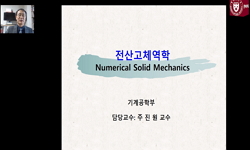본 논문에서는 연성 매설관과 지표 상재하중의 상호작용에 관한 내용을 다루었다. 본 연구에서는 유한요소해석을 이용한 매개변수 연구를 수행하였으며, 이와 아울러서 적용된 유한요소해...
http://chineseinput.net/에서 pinyin(병음)방식으로 중국어를 변환할 수 있습니다.
변환된 중국어를 복사하여 사용하시면 됩니다.
- 中文 을 입력하시려면 zhongwen을 입력하시고 space를누르시면됩니다.
- 北京 을 입력하시려면 beijing을 입력하시고 space를 누르시면 됩니다.
https://www.riss.kr/link?id=A106697886
- 저자
- 발행기관
- 학술지명
- 권호사항
-
발행연도
1999
-
작성언어
English
- 주제어
-
자료형태
학술저널
- 발행기관 URL
-
수록면
83-97(15쪽)
- 제공처
- 소장기관
-
0
상세조회 -
0
다운로드
부가정보
국문 초록 (Abstract)
본 논문에서는 연성 매설관과 지표 상재하중의 상호작용에 관한 내용을 다루었다. 본 연구에서는 유한요소해석을 이용한 매개변수 연구를 수행하였으며, 이와 아울러서 적용된 유한요소해석 모형의 검증 및 지표 상재하중을 부담하는 연성 매설관의 거동 파악을 목적으로 실내모형실험을 수행하였다. 해석결과를 토대로 지반/매설관 접촉면에서의 연직응력 및 파이프의 축력 분포 경향 등 지표 상재 하중하에서 매설관의 하중응답 특성을 구체적으로 고찰하였으며, 그 결과를 종합적으로 분석하여 추후 수행될 보다 효율적인 매설관 설계/해석법의 개발에 사용될 데이터 베이스를 구축하였다. 해석결과를 분석한 결과 매설관과 지표 상재하중의 상호작용 정도는 매설관과 상재하중의 상대적 위치에 따라 좌우되며, 지반-구조물 상호작용을 고려하지 않고 있는 현 설계방법은 연성 매설관의 지표 상재 하중에 대한 응답특성을 효율적으로 반영하지 못하는 것으로 나타났다. 또한 본 연구의 결과를 토대로 지표 상재하중에 의한 연성 매설관의 최대 축력을 예측할 수 있는 반경험적 평가식을 제시하였다.
다국어 초록 (Multilingual Abstract)
This paper presents the results of a parametric study on the interaction between buried pipes and surface load using the finite element method of analysis. A series of laboratory model tests were also performed in order to validate the adopted finite ...
This paper presents the results of a parametric study on the interaction between buried pipes and surface load using the finite element method of analysis. A series of laboratory model tests were also performed in order to validate the adopted finite element model and to capture essential features of the physical behavior of buried pipes subjected to surface load. In the parametric study, a wide range of boundary conditions were analyzed with emphasis on the response of the buried pipes to surface load. The results of analysis such as contact stress distribution at the soil/pipe interface and axial thrust of the pipe were thoroughly analyzed, and a database on the response of buried pipe under surface load was established for future development of a semi-empirical design/analysis method. The results indicated that the degree of interaction between buried pipes and surface load significantly varies with the vertical and lateral location of pipe with respect to surface load, and that the current design method, which does not consider soil-structure interaction, cannot correctly capture the pipe response to surface loading. Furthermore, based on the results of analysis, a semi-empirical equation was suggested, which estimates the maximum pipe thrust due to surface load for flexible buried pipes.
동일학술지(권/호) 다른 논문
-
An Experiment of Consolidation Behavior for Partly and Fully Penetrated SCP Ground
- Korean Geotechnical Society
- Jung, Jong-Bum
- 1999
-
Quantification of Surface Topography Using Digital Image Analysis
- Korean Geotechnical Society
- Lee, Seok-Won
- 1999
-
Development of Landfill Material by Utilizing Waste Lime
- Korean Geotechnical Society
- Shin, Eun-Chul
- 1999
-
Slope Failure Surface Using Finite Element Method
- Korean Geotechnical Society
- Ahn, Tae-Bong
- 1999




 ScienceON
ScienceON







